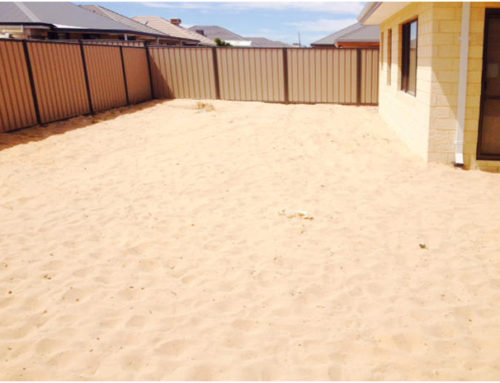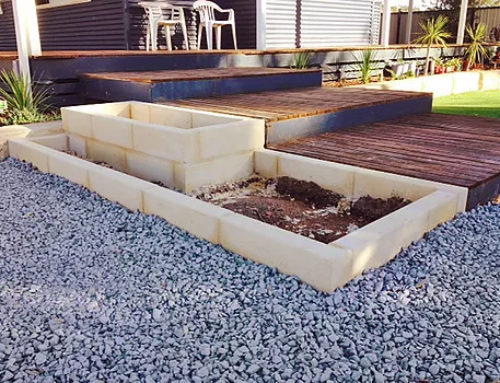Whether looking out at a blank canvas, or working with what your yard already is, it can be daunting figuring out where to spend money, what to put in, and in which order to do it. If you want to DIY at least the design of your yard, it can be handy to have a list so you can take it one step at a time. Below are a few guide points that you might find helpful.
Every yard is different, making it impossible to create an exact formula, but reading down the page, you might find that breaking the process into baby steps might lead you in the right direction.
- Look at what existing elements you want to keep.
There might be nothing you feel you want to keep. You may only be happy with the perimeter fence. You might have plants you like, but they might be in the wrong spot. You might have pavers lying around that you want to incorporate into the landscape. Perhaps your barbeque is used frequently enough to be reserved a permanent place in the landscape. The washing line might be in the perfect spot for practical reasons, but not very nice to look at.
- Consider the necessary landscaping.
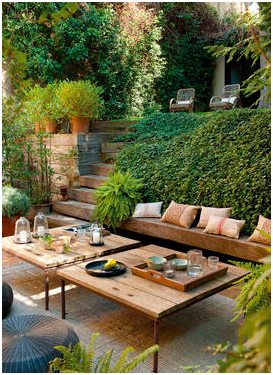
You might not be able to determine this on your own. It may not be until you acquire the help of a professional that you know what is essential to the landscape. But consider the varying heights of the property. If your yard is sloped, even a small amount, you will need to consider whether you want it to remain sloped, or if you will be putting in retaining to create differing levels.
Levels in your garden can create depth. Even if your property is completely flat, you may consider adding varying levels, such as raised garden beds, a decked area, or even a sunken place where you can feel you are tucked away in the garden.
Above: Having a sloped yard needn’t be seen as a negative. Work with what you have to create levels within your landscape.
Necessary landscaping might include a place for bins, or a washing line, a pathway down the side of the house, or a gate enclosing the carport. Remember to consider existing trees, as it will be necessary to consider their roots, whether you will be keeping them, what leaves they drop, and whether it will be possible to dig near them.
- Create a ‘practical elements‘ landscaping wish list.
Practical elements in your landscaping should be considered well before you consider the aesthetics. Particularly in your rear yard, aim to use the space, rather than focusing on making it beautiful. The practical elements are what your style will revolve around.
Practical elements include seating and the kind of seating such as formal or informal, lounge, undercover, swing, entertaining, or dining. Consider what you would like to use your yard for, now and in the future. You may want to consider what will add value to your property.
Include play areas for children, pathways, grassed areas, outdoor cooking areas, herb gardens, shaded areas, areas for animals, or swimming pools. You don’t need to know where they are going to go, or how you will incorporate it all together. If you do nothing else listed here before you call in an expert, always make a list of your practical elements.
- Hardscape: Define your areas.
Now that you know what you want to keep or include, what is necessary to be done, and what new areas you want to include, it’s time to draw. You will be drawing a birds eye view of the total area, and outlining your hardscape. This includes structures, such as fencing, retaining, pathways, gazebos, garden beds, benches, patios, hard wired garden lighting, and anything to be built, rather than planted. Consider reticulation and drainage, such as soakwells. If you want practical areas that you don’t want to look at directly from the back door, include screening, and consider making that a practical element also to disguise your intentions.
Of course, at this point, you might be happy to skip straight to the last step. You might be clueless as to where things should go, or you might have a reason to want the kids play area directly in front of the kitchen window, and away from the barbeque, for example.
Your hardscaping does not need to include definite material choices. These will be determined by your style choice, and budget. You also don’t need to include the types of plants, so much as where the garden beds will be. Your plants will again be determined by your style and budget, but also what you may already have in your area, and what will grow well given the amount of sunlight the garden bed will receive.
- Determine your style.
You don’t need to know how to describe your style, as words can miscommunicate what you want to achieve, as there are styles within styles. Look online, use Pinterest or Google or the weapon of your choice to choose pictures that demonstrate what you like. Try to note what you like about them. This will create your ‘mood board’, and will far better reflect the style you like. Gather the images in a format that you can share; on a CD, on a Pinterest board, in an email or in a folder you can bring up as a gallery on your computer screen.
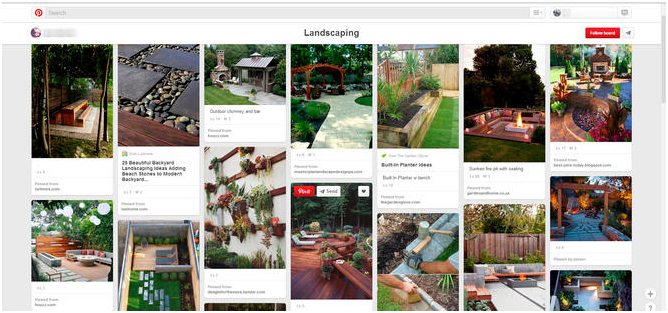
Above: Create a Pinterest board to store all of your images in one place, and easily refer others to it.
- Call a landscaper for options and a quote.
Now is a good time to discuss all your hard work, determining what you have, what you want, and what you need. Show your pictures for your style. Talk about your budget if you are comfortable doing so. Landscaping an entire area will take more than one conversation. While you have determined what you would ideally like, keep an open mind when it comes to materials and time frames for keeping within your budget. Prioritise what matters most in your landscape.
Remember that any landscaper is there with you to make a living, so while taking advantage of a free quote and advice, you might want to ask for ball park figures for the each stage of the landscaping, but for firm quotes that involve measuring up, only request quotes for what you might realistically consider you might have done right away. Remember also that quoted prices are subject to a time frame, so requesting firm quotes for something you won’t do for six months might as well only be a ball park figure anyway. Having a good relationship with someone responsible for making your landscape beautiful is always a good idea.
Remember to ask about the terms and conditions for any quote. Even a firm quote in landscaping can change subject to the terms and conditions once work commences. Unexpected costs could include underground obstructions such as tree stumps or roots, existing reticulation or ancient lost cities buried under the garden.
Your landscaper should be able to quote you for different material options, such as concrete or liquid limestone, timber slat screening or lattice, limestone block retaining or panel and post. You should also ask to receive a quote written up in stages, so you can add to your landscape bit by bit as your budget allows.
What works well aesthetically:
You might be a very particular person, and know exactly what you like by way of materials, and you might have a fair idea of what’s available and what it will look like.
If choosing your hardscaping materials yourself, as you will be, even with the helpful advice of a landscaper, it will still be up to you to decide, there are some things to consider. You should be aiming to create the right balance of consistency and contrast.
Consistency will be in the style of your landscape. The ‘theme’ you choose, such as a modern landscape, a cottage garden, a water-wise native garden, or a Balinese style retreat. It might also mean all of your garden borders use the same materials, or all of your retaining has capping. Consistency will make your landscape look planned, and will tie it all together.
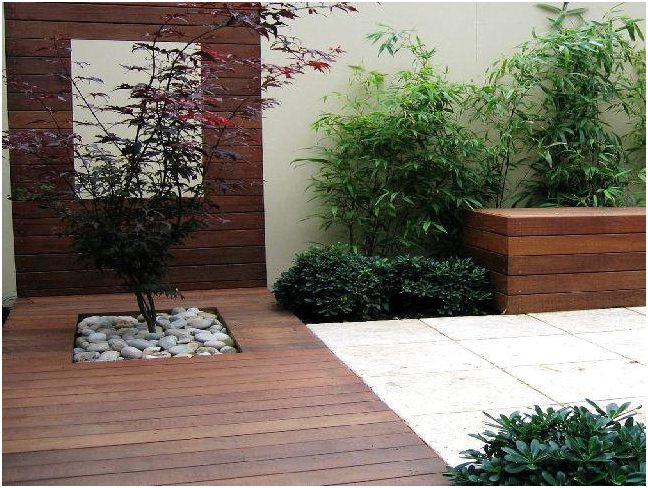
Above: The use of timber as a repeating element in this landscape, used in a different way, ties the landscape together and creates consistency. The pebbles under the tree create a contrasting texture, and the colour of the pavers also add contrast against the timber.
Contrast means using different materials for different features, including hard and soft features, rough and smooth, light and dark, fine and course, straight and curved. It can be difficult to make things tie in, but contrast.
These rules for consistency and contrast applys also to the choice of plants. The leaf size and colours of your plants need to be considered, as well as to fit with the chosen style of your landscape. Repeating plants aren’t just for hedges. Using the same plant in a cluster, or throughout your garden can create consistency.
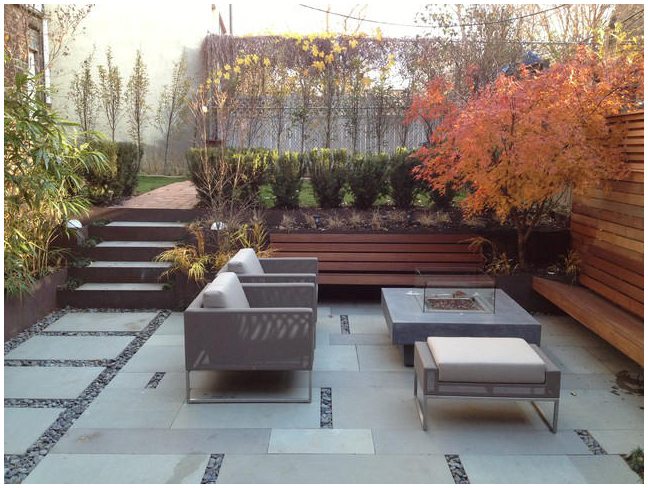
Above: Contrasting but repeating elements have been used in this landscape; the texture of the pebbles, the light, smooth pavers, the natural wood. All of the repeating elements engage with each other, used not just next to each other but in amongst one another.

